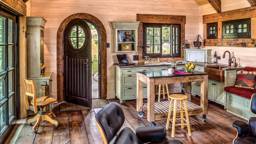
Many cabin owners are well on their way down the green path, choosing new and remodeled dwellings designed with energy-saving features, healthy indoor air, water efficiency and environmentally responsible building materials. From simply changing out light bulbs with compact fluorescents to replacing old single-pane windows with new double or triple pane windows, there are many ways to add Earth-friendly efficiency to a home. Some green building strategies even result in saving money and often help keep a cabin’s occupants healthy. So why wait? Here are the ten trends totally worth trying out in green cabin design, remodeling and maintenance:
Keep it Small.
The smaller the cabin, the less material it takes to build, the less energy to heat and cool, and the less time to clean and maintain. If you need to add more room for sleeping, consider a window seat (sized for a twin mattress), bunk bed, trundle bed or Murphy bed. Create a semi-enclosed outdoor room for expanded dining and living space.
Aging In Place.
Accessibility within our homes is often overlooked as a green building strategy. Planning to aid mobility while in the process of aging and disability can extend the use of our cabins. 36-inch-wide doorways and the elimination of steps and tripping hazards are simple techniques to accommodate the elderly and disabled.
Durability.
A durable residence usually requires less maintenance. The added investment in durable materials (like metal-clad windows that don’t need repainting or stainless-steel flashing that resists corrosion) and design (like gutters and downspouts that divert rainwater away from the cabin) is small in comparison to the impacts and costs of shoddy construction and cheap materials.
Salvaged Materials.
There are few limits on the potential to reuse materials and products found in salvage yards, thrift stores and garage sales. Hardware, plumbing fixtures, interior doors, flooring, large timbers, cabinetry and light fixtures are easily converted for reuse. The casual and eclectic look is both green and fashionable.
High-performance Insulation.
Closed-cell spray foam is an excellent material to insulate walls, roofs and under floors. It also helps reduce air infiltration. Nail base is a sandwich of rigid foam board and plywood that is usually applied over roof rafters and under the roofing surface. Nail base works equally well when set to the outside of wall framing and under exterior siding material.
Ductless Heating & Cooling Systems.
Mini-split heat pump systems provide energy-efficient heating and cooling without the need for air ducts. Though they work well for new homes, they are especially appealing for remodels, or when supplemental heating or cooling is needed.
Heat Recovery Ventilators.
Once a cabin is well insulated and sealed, mechanical ventilation with heat recovery ventilators (HRVs) can both save energy and improve the indoor air quality of our cabins. HRVs simply transfer the heat from exhaust air to the incoming air. Small units are available for bathroom exhaust fans.
Solar-electric Energy.
Once your cabin is well insulated and equipped with energy-efficient appliances and lighting, you may be a candidate for a solar-electric system. Being connected to the grid will likely enable you to sell your excess power back to your electric power provider. A stand-alone system with batteries is also a very good back-up power system.
A Healthy Home.
One of the main elements of a green home is a clean and healthy home. Quite a bit of attention is given to mold and mildew as a source of asthma and respiratory problems. However, more is becoming known about dust mites as a more significant source of respiratory problems. One strategy to combat dust mites is by reducing the amount of carpet in a home, and using non-porous wood, concrete, bamboo and linoleum flooring.
Food Production.
Vegetable gardens at our cabins reduce the environmental impact associated with transporting our food from distant locations and can be grown free of pesticides and herbicides. Greenhouses extend the growing season and enable more diversity in garden plant varieties.










